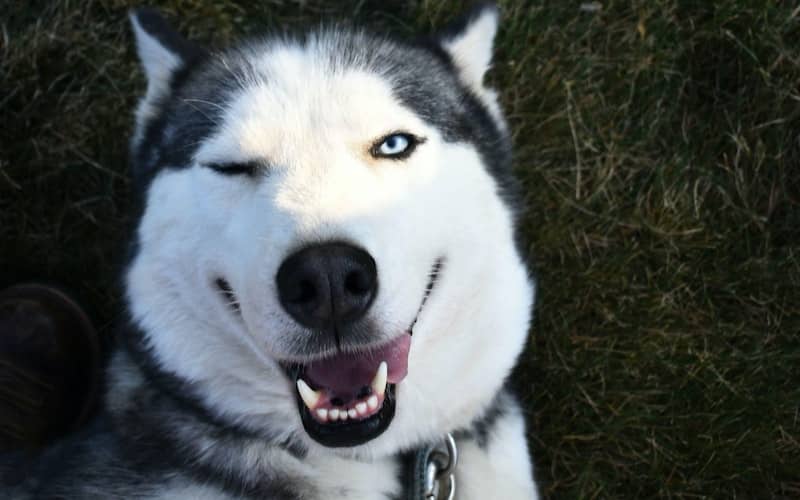The Dog Tale is reader-supported. We may earn a commission if you buy something through our site; this doesn’t change our recommendations.
Have you ever wondered if dogs have eyelashes or eyebrows, or what purpose the hairs on their faces serve? Do you feel like your dog’s eyelashes need a trim and you’re wondering if it’s safe? In this overview, we will discuss dog eyelashes, their grooming needs, and common eyelash disorders. Keep reading to find out more.
In this guide:
- Do dogs have eyelashes?
- Can I cut my dog’s eyelashes
- Do dog eyelashes grow back
- Dog breeds with long eyelashes
- Dog eyelash disorders
- Do dogs have eyebrows?
Do dogs have eyelashes?
Yes! Dogs indeed have eyelashes! In fact, they have two to four rows of eyelashes along the upper eyelid, but none along the lower eyelid.
Just like humans, dogs’ eyelashes are sensitive to touch, which makes them tactile organs, explains Veterinarian Kevin Kaise of Animal Eye Clinic in Spokane, WA.7 Eyelashes help prevent eye injury by telling the eye to close when something is interpreted as harmful.
Can I cut my dog’s eyelashes?
Yes, you can trim your dog’s eyelashes. It’s usually a cosmetic preference similar to the choice of how to trim their fur. Trimming is probably a good idea if you notice the lashes getting long and obstructing the dog’s vision.
But if the dog has short eyelashes, as most do, you’re better off leaving the lashes alone. They do serve a purpose and you also eliminate the chance of injuring their eyes.
>> Read more: Can You Use Human Clippers on Dogs?
Do dog eyelashes grow back?
Yes, your dog’s eyelashes will grow back if you decide to trim them. It will probably take about a month or so for them to fully grow back depending on the eyelash length when full-grown.
>> Read more: Best Dog Grooming Clippers
Dog breeds with long eyelashes
Dog breeds with longer fur tend to have longer eyelashes. Some of these long-haired breeds are:
- Cocker Spaniels
- Old English Sheepdog
- Maltese
- Yorkshire Terriers
- Lhasa Apsos
- Shih Tzus
- Poodles
A pair of Cocker spaniels named Cloe and Nena are becoming viral social media sensations with their natural, luscious lashes measuring up to six centimeters long!1 That’s a little longer than a golf tee! But, the world record holder for longest eyelashes on a dog is Ranmaru, an Australian Labradoodle from Japan. One of Ranmaru’s eyelashes measures 6.69 inches!
Dog eyelash disorders
There are several health issues that can arise with dog eyelashes. Here are a few of the common disorders.
Trichiasis
Trichiasis is the condition when hairs from normal follicle locations are misdirected toward the eye and rub against the cornea or inside lining of the eyelid.4 Sometimes it occurs if a dog has long eyelashes or facial hair or had previous trauma to the eye.
Trichiasis is prominent in young dogs and brachycephalic (short-nosed) breeds, such as Pekingese, Pugs, Shih Tzus, Lhasa Apsos, and Bulldog, as well as breeds that have long hair around their eyes like the American Cocker Spaniel.
Symptoms
Trichiasis symptoms include excess watering (epiphora), pain, itchiness, squinting or blinking, dark pigmentation of the eye, blood vessels in the cornea area, and possible eye infection. Often, trichiasis causes dogs to develop tear stains on their fur below their eyes.4
Your veterinarian may suggest surgery to remedy the issue.
>> Read more: Best Dog Tear Stain Removers
Distichiasis
Sometimes dogs can have an abnormal eyelash, called a distichia, that grows in an unusual location along the eyelid. One place the distachia may grow is in the meibomian glands, which produce lubricants for the eye.2 These abnormal hairs can be on the upper or lower lid, despite dogs not having eyelashes on the lower eyelids. The condition is called distichiasis.
It is not known why certain eyelash follicles grow in these abnormal locations, but veterinarians believe that the condition is hereditary in certain breeds. Some of these breeds include:
American Cocker Spaniel, Cavalier King Charles Spaniel, Shih Tzu, Lhasa Apso, Dachshund, Shetland Sheepdog, Golden Retriever, Chesapeake Retriever, Bulldog, Boston Terrier, Pug, Boxer Dog, and Pekingese.
Symptoms
Depending on the severity of your dog’s distichiasis, symptoms can include redness and irritation, eye discharge, pain, excessive tearing (epiphora), and excessive blinking or squinting.2
If left untreated, the dog’s cornea could become ulcerated and may appear bluish and less shiny. If it’s painful for the dog, he or she may paw at the affected eye.
- Protect your pet in seconds
- Accident & Illness + Optional Wellness coverage available
- Policies start at just $9.99/mo
Ectopic cilia
Ectopic cilia is a short, stiff eyelash that grows from the underside of the upper or lower eyelid.3 This abnormal eyelash grows toward the eye and can be quite uncomfortable with every blink.4
Symptoms
Dogs with ectopic cilia usually have excessive tearing, redness, possible discharge, and corneal ulcerations. These hairs are not usually visible to the naked eye, so it’s important to have your vet check your pup with a handheld microscope.
If your pup does have ectopic cilia, it’s usually treated with surgical removal or possible cryotherapy (freeze therapy) under anesthesia.3
Do dogs have eyebrows?
Dogs don’t technically have eyebrows as humans do, but they do have muscles above their eyes. These muscles do not serve the same purpose as human eyebrows, either, but they can sometimes give the appearance of eyebrows.
Scientists believe that over thousands of years of domestication, dogs have gradually developed expressive eyebrows as a “result of selection based on humans’ preferences.”5
In other words, we choose dogs that can communicate through expressive “puppy dog eyes,” which is similar to the mother-infant attachment cycle that occurs through gazing.5 We interpret this gazing as nurturing and communicative and are more likely to nurture the pup as a result.
While all dogs have these muscles, only a few breeds have eyebrow markings. It is not known why these markings exist, but it is thought that they help dogs communicate.6
Dog breeds with eyebrow markings
- Rottweilers
- Labrador Retrievers
- Gordon Setters
- Bernese Mountain Dogs
- German Shepherds
- Dobermans
The Best Dog Eye Wipes for Safe Eye Cleaning
Let's bark a little
Get our latest updates and articles right in your email.
We won't bark too much. Promise.
References
- New York Post. Internet falls in love with these dogs with freakishly long eyelashes
- Yuill, C., & Llera, R. Distichia or Distichiasis in Dogs
- Eye Care for Animals. Distichiasis, Trichiasis and Ectopic Cilia
- Eye Specialists for Animals. Ectopic Cilia
- Kaminski, J., Waller, B., Diogo, R., Hartstone-Rose, A., Burrows, A. Evolution of facial muscle anatomy in dogs
- Siniscalchi, M., D’Ingeo, S., Minunno, M., Quaranta, A. Communication in Dogs
- Ask Dr. Universe: Washington State University. Why do we have eyelashes?


